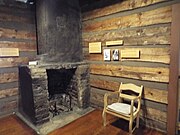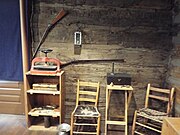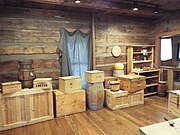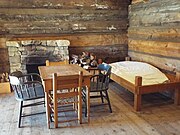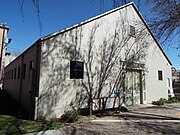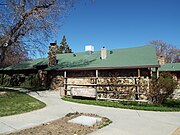
Seligman is a census-designated place (CDP) on the northern border of Yavapai County, in northwestern Arizona, United States. The population was 456 at the 2020 census. It is one of the stops on historic U.S. Route 66.

The Arizona Historical Society (AHS) is a non-profit organization whose mission is to connect people through the power of Arizona's history. It does this through four regional divisions. Each division has a representative museum. The statewide divisions are as follows: Southern Arizona Division in Tucson, the Central Arizona Division in Tempe, the Northern Arizona Division in Flagstaff, and the Rio Colorado Division in Yuma. It was founded in 1884.

Old Fort Harrod State Park is a park located in Harrodsburg, Kentucky in the United States. The park encompasses 15 acres (6.1 ha) and features a reconstruction of Fort Harrod, the first permanent American settlement in the state of Kentucky. The park was founded in November 1934 as Pioneer Memorial State Park, and dedicated by President Franklin D. Roosevelt and Governor Ruby Laffoon.

Fort Whipple is a former United States (U.S.) Army post that was temporarily established at Del Rio Springs, north of present-day Chino Valley, Arizona, and later relocated to a permanent site near present-day Prescott, Arizona.

The dogtrot, also known as a breezeway house, dog-run, or possum-trot, is a style of house that was common throughout the Southeastern United States during the 19th and early 20th centuries. Some theories place its origins in the southern Appalachian Mountains. Some scholars believe the style developed in the post-Revolution frontiers of Kentucky and Tennessee. Others note its presence in the South Carolina Lowcountry from an early period. The main style point was a large breezeway through the center of the house to cool occupants in the hot southern climate.
The 1st Arizona Territorial Legislative Assembly was a session of the Arizona Territorial Legislature which began on September 26, 1864, in Prescott, Arizona, and ran for forty-three days. The session was responsible for enacting Arizona's first legal code, creation of the territory's first four counties, and authorizing a volunteer militia to fight hostile Indians.
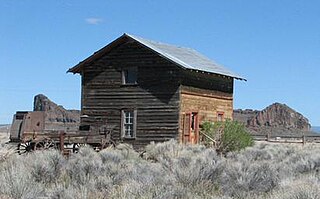
The Fort Rock Valley Historical Homestead Museum is located in Fort Rock, Oregon, United States. Opened in 1988, it is a collection of original homestead-era buildings including a church, school, houses, homestead cabins, and several other buildings assembled in a village setting. The structures were moved to the museum site from various locations around the Fort Rock Valley, named for volcanic landmark Fort Rock. Most of the buildings contain historic items used by local homesteaders including furniture, dishes, household products, and tools. The museum is open for self-guided tours from Memorial Day weekend through Labor Day weekend.

Sharlot Mabridth Hall was an American journalist, poet and historian. She was the first woman to hold an office in the Arizona Territorial government and her personal collection of photographs and artifacts served as the starting collection for a history museum which bears her name.
Fort Misery may refer to:
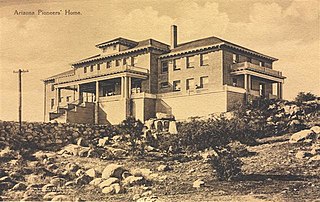
The Arizona Pioneers' Home, also known as the Home for Arizona Pioneers and State Hospital for Disabled Miners, is a retirement home in Prescott, Arizona, established to provide housing for early Arizona pioneers. The home is operated and funded by the state of Arizona. The building is listed on the National Register of Historic Places.

Kate Cory was an American photographer and artist. She studied art in New York, and then worked as commercial artist. She traveled to the southwestern United States in 1905 and lived among the Hopi for several years, recording their lives in about 600 photographs.

The Pioneer Living History Museum is located at 3901 W. Pioneer Road in Phoenix, Arizona. The museum, also known as Pioneer Village, has 30 historic original and reconstructed buildings from the 1880s and early 1900s on its 90-acre property.







